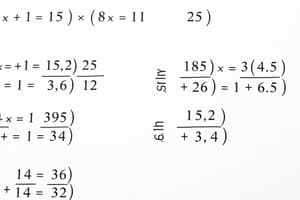Podcast
Questions and Answers
What is the purpose of finding the Greatest Common Factor (GCF) of a polynomial?
What is the purpose of finding the Greatest Common Factor (GCF) of a polynomial?
- To simplify the polynomial and make it easier to work with (correct)
- To find the degree of the polynomial
- To graph the polynomial
- To determine the roots of the polynomial
What is the factored form of the quadratic expression x^2 + 5x + 6?
What is the factored form of the quadratic expression x^2 + 5x + 6?
- (x + 2)(x + 3)
- (x + 3)(x + 2) (correct)
- (x + 1)(x - 6)
- (x + 1)(x + 6)
What is the formula for factoring a difference of cubes?
What is the formula for factoring a difference of cubes?
- (a - b)(a^2 + ab + b^2) (correct)
- (a + b)(a^2 - ab - b^2)
- (a + b)(a^2 + ab - b^2)
- (a - b)(a^2 - ab + b^2)
How can the GCF be used to simplify a polynomial?
How can the GCF be used to simplify a polynomial?
What is the factored form of the sum of cubes x^3 + 8?
What is the factored form of the sum of cubes x^3 + 8?
What is the purpose of factoring quadratic expressions?
What is the purpose of factoring quadratic expressions?
Flashcards are hidden until you start studying
Study Notes
Greatest Common Factor (GCF)
- The GCF is the largest number that divides two or more integers without leaving a remainder.
- To find the GCF of a polynomial, list the factors of each term and identify the common factors.
- The GCF can be a single variable, a constant, or a combination of variables and constants.
Factoring Out Greatest Common Factor
- Factoring out the GCF involves dividing each term of the polynomial by the GCF.
- This is useful for simplifying polynomials and making them easier to work with.
- Example: Factor out the GCF from 6x^2 + 12x
- GCF = 6x
- Factored form: 6x(x + 2)
Factoring Quadratic Expressions
- A quadratic expression is a polynomial of degree two, in the form ax^2 + bx + c.
- Factoring quadratic expressions involves expressing them as a product of two binomials.
- There are several methods for factoring quadratic expressions, including:
- Factoring out the GCF
- Using the "ac method" (where a and c are the coefficients of the x^2 and constant terms)
- Using the " guessing method" (where you try different combinations of factors)
- Example: Factor the quadratic expression x^2 + 5x + 6
- Factored form: (x + 3)(x + 2)
Factoring Sums and Differences of Cubes
- A sum of cubes is a polynomial in the form a^3 + b^3.
- A difference of cubes is a polynomial in the form a^3 - b^3.
- Factoring sums and differences of cubes involves using the following formulas:
- a^3 + b^3 = (a + b)(a^2 - ab + b^2)
- a^3 - b^3 = (a - b)(a^2 + ab + b^2)
- Example: Factor the sum of cubes x^3 + 8
- Factored form: (x + 2)(x^2 - 2x + 4)
Greatest Common Factor (GCF)
- The GCF is the largest number that divides two or more integers without leaving a remainder.
- To find the GCF of a polynomial, list the factors of each term and identify the common factors.
- The GCF can be a single variable, a constant, or a combination of variables and constants.
Factoring Out Greatest Common Factor
- Factoring out the GCF involves dividing each term of the polynomial by the GCF.
- This process simplifies polynomials and makes them easier to work with.
- Example: Factoring out the GCF from 6x^2 + 12x results in 6x(x + 2).
Factoring Quadratic Expressions
- A quadratic expression is a polynomial of degree two, in the form ax^2 + bx + c.
- Factoring quadratic expressions involves expressing them as a product of two binomials.
- Methods for factoring quadratic expressions include:
- Factoring out the GCF.
- Using the "ac method" (where a and c are the coefficients of the x^2 and constant terms).
- Using the "guessing method" (where you try different combinations of factors).
- Example: Factoring the quadratic expression x^2 + 5x + 6 results in (x + 3)(x + 2).
Factoring Sums and Differences of Cubes
- A sum of cubes is a polynomial in the form a^3 + b^3.
- A difference of cubes is a polynomial in the form a^3 - b^3.
- Factoring sums and differences of cubes involves using the formulas:
- a^3 + b^3 = (a + b)(a^2 - ab + b^2).
- a^3 - b^3 = (a - b)(a^2 + ab + b^2).
- Example: Factoring the sum of cubes x^3 + 8 results in (x + 2)(x^2 - 2x + 4).
Studying That Suits You
Use AI to generate personalized quizzes and flashcards to suit your learning preferences.




